-
Content Count
1,500 -
Joined
-
Last visited
Content Type
Profiles
Forums
Calendar
Posts posted by angelfj
-
-
This drawing is from my Bentley Shop Manual.

Has anyone actually seen a reconditioned engine identified by one of these plates? Where was the plate fitted? Have a photo?
Thanks in advance
Frank
-
Nice, very nice! Another powder blue TR hits the streets again!
Hope you enjoy many trouble free miles with the car.
Menno
Yes, another powder blue, and he's not Dutch - amazing!
A very lovely car!
-
Hello frank and peter,
Thankyou both for your replies,i am having this done locally at a company that does alot for us at work,so the reputation is good.
i have gone with the yellowy plating as that is in keeping with a 1968 tr5.
I was was worried about the so called melting,but have spoken to them and have their assurance.
So happy days...untill i have to pay......but these tr`s are not cheap to restore !
All the best,
Conrad.
openroad great! glad that you have that sorted
cheers
-
This is probably the same for all tr`s,but do i go for bright zinc plating,or the slightly yellowy colour. ?
I am doing the door locks,bonnet catch,accelerator ,seat runners etc.
Cheers,
Conrad.
This is probably the same for all tr`s,but do i go for bright zinc plating,or the slightly yellowy colour. ?
I am doing the door locks,bonnet catch,accelerator ,seat runners etc.
Cheers,
Conrad.
Hello Conrad. A small story is appropriate I think. In restoring the TR3A, we sent lots of bits and bobs off to be plated. Along the way, I learned some of the secrets to success for this type of refurbishment. The appearance of your parts is directly proportional to the amount of work you put into the preparation. Don't expect heavily pitted parts to come back smooth and shiny. Unless you contract for polishing this will not be included. it is best to discuss your expectations with the plater, maybe borrow a good finished example and bring this plus your part so he knows what you want. It is possible to prepare your own parts for plating. A small abrasive wheel and a buffing wheel with a few progressively finer buffing compounds can improve the final appearance. Remember, the zinc layer is very thin and basically transparent.
Here's an example of some parts that we wanted to save and how they looked after re-plating with clear zinc. The yellow , green and other coloured zincs are NOT correct for early cars. I would say that perhaps starting with the TR5/250 the yellow, "iradite" started to appear. When we began in 2001, our plater charged $40 for anything you could fit into a 1 gallon bucket. Now, he charges $110 for the same, due to all of the environmental regs, etc. Is it the same in the UK?
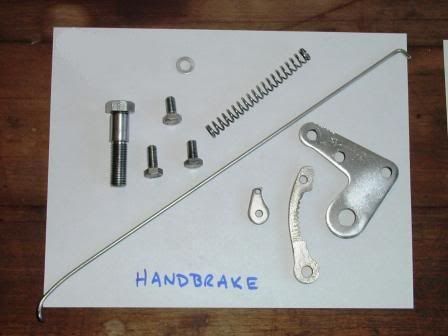
-
We static balanced the fan on our 3A. Another type of balance, dynamic balance, requires special equipment, similar to that used to balance your tires.
Have you ever balanced a lawnmower blade? This will be similar. See sketch below
First remove the fan from the hub.
Clean it up and remove all attachment hardware
Check for loose rivets and cracks around the rivet holes. If you find cracks, you fan is toast. If you find loose rivets, carefully peen them tight.
You need a temporary shaft on which to mount the fan and a pair of knife edge supports.
We used some scrap lumber and a couple of utility knife blades
Place the fan on the shaft and then onto the knife edges
The supports/knife edges must be dead level
The object is now to get the fan to remain exactly horizontal without dropping one blade. Commercially, they balance fan blades by either adding weight to the lightest blade (the one that rises up) or removing it from the heaviest blade The best place to add or remove weight is at the center of gravity of each blade. Triumph has incorporated a little piece of metal, a balance piece, which can be moved in and out until balance is achieved. We found the best approach was to first balance the fan sans all hardware, including the balancing piece. We did this and found that there was one heavy blade. Using a small grinder, we carefully removed material from the steel spider (not the blade) of that heavy one, until we got a good balance. Once you have the blade balanced, rotate it 180 degrees and check to be sure it's still in balance. If not, then your blade edges aren't level or the shaft is out of true. You can spend as long as you wish on balancing - once you get to the point where the blades will only rotate a few degrees from level then that's probably more than good enough. Now you can replace the hardware and check its effect on balance. You will find a point where the balance piece location is neutral. Then do one more 180 degree rotation. If it is still in balance you can mark the position of the balance plate and remount your fan. Once back on the engine our fan ran true without noticeable wobble or vibration.
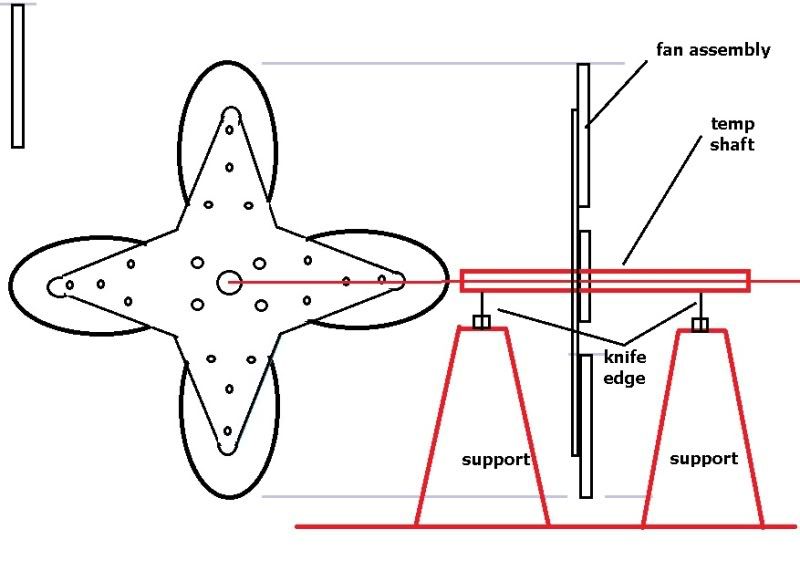
-
If you use the tropical fan must you also wear a pith helmet ?
Remember Ramar of the jungle?
-
Frank
How did you get the fan so clean ?
Cheers
Alan
popped it in the dishwasher when she who must be obeyed was out!
-
Whilst removing my dynamo today I was able to take a good look at the fan. I have been suffering from poor cooling and I noticed that the blades were bent well out of shape to the extent that they would be working at significantly less than optimal performance.
I was (pleasantly) surprised that the actual blades seem to be made of a fairly soft material and could fairly easily be reshaped to provide the correct air flow using a large pair of long nose pliers. No need to remove the fan which is a real pain!
Presumably over the years they had become bent out of shape by manhandling because they were so soft.
Anyway if you are having any cooling problems check yours.
Ian
Ian: If you do remove the fan be sure to check that all of the rivets which fasten the aluminium blades to the steel cruciform haven't loosened. If they are loose check for stress cracks radiating from the rivet holes. If the blades are cracked, your fan is toast and you need another.
Another option for increased cooling air is to fit a "tropical" fan.
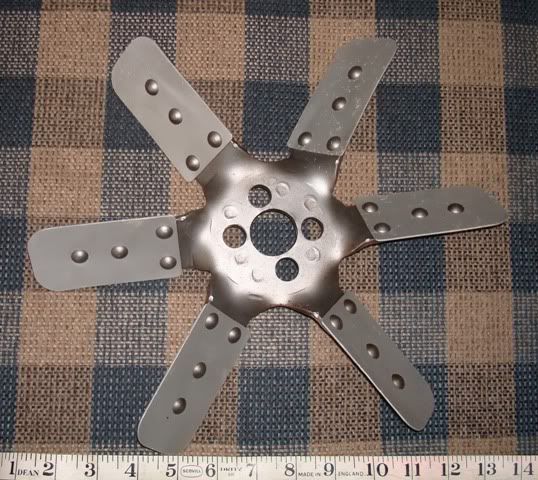
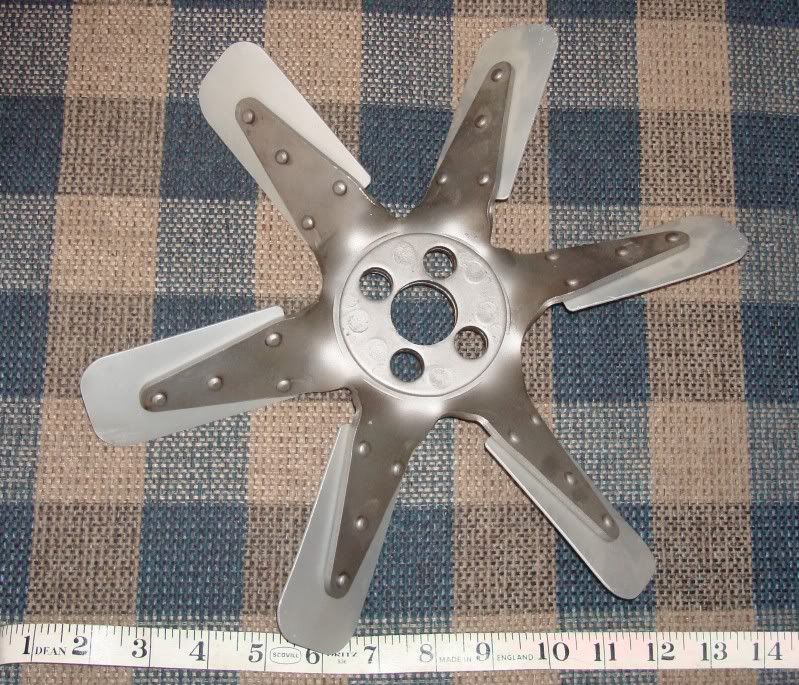
-
Very interesting Brett. Anyone know what the instrument 'indirect blue lighting' refers to?
Jerry
The speedometer and tachometer on my TR250 have blue plastic filters for the instrument lamps. The small gauges have a thin plastic film (tape) to accomplish the same effect. The blue was changed to green later for the TR6.
Cheers
-
Hi All,
As I've just had another birthday I decided to put my cash presents toward a replacement carpet set for my TR4a. That is when the fun starts .No one can, or will tell me what quality of carpet was fitted as standard when the car was made, were they tufted,were they wool? Anyone out there who can shed some light on this subject, together with any advice as to where to, or not, purchase them from would be appreciated.
Cheers
Phil
Hi Phil. My first TR was a 1967 TR4A. BRG with a black interior. I am fairly sure that the carpet was nylon loop rather than a cut pile.
Cheers
-
So far I have seen the bracket for the latch painted body color, black and now plated in the pics from Stuart. Which one is correct and was the bonnet support rod always black or was that body color also ?
Stan
Stan: My friend Brian and I have done a great deal of research on this and related issues. We understand that there could have been exceptions and variations. However, we are fairly confident that this assembly was already attached to the bonnet before it entered the paint line at Mulliners and thus was sprayed body color. Same goes for the boot latch assembly and prop rod.
-
Outstanding!!! That's the ticket
Cheers,
Frank
-
Thanks Stuart. That's a good shot but I was wondering how the spring was oriented. problem is I'm sitting here with a pile of parts.
-
anyone have a close-up photo of this assembly?
thanks in advance
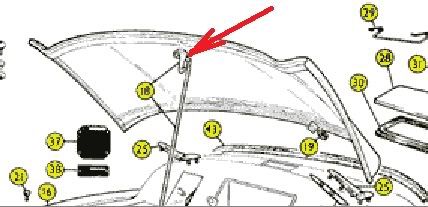
-
Hi Ian,
your gauge needs 12V if you stick 10V across it it will not deflect fully.
You can feed 10V to the thermogauge from the stabiliser, and 12V across the Fuel gauge.
Roger
Roger, with a 10 volt supply wouldn't he consume less petrol???
Sorry, I'm just leaving.
-
-
Looks good, great colour and trim choices!
ians, you have great taste!
-
Nice one Frank, mind you did start with a lot more than we usually have over here
Stuart.
Seriously? I'd love to see before and after photos if you'd like to share them with us.
-
Thank you all for the compliments. This has been a daunting task which never would have been possible without your help and encouragement.
For Menno, in keeping with the original build record, the weather equipment (top & sidescreens) are black. Only black, white and fawn were offered in 1959. A pity I think, since red seems to compliment the Silverstone Grey so well. However, I do have a red hood stick cover and tonneau, which should look grand! Future plans include a red top.
-
I quite like the look of tatty paint with the occassional rusty bubble popping through - sort of in-keeping with the TRiumph look.
Roger
Oh, you mean like this when we began the project over 10 years ago.
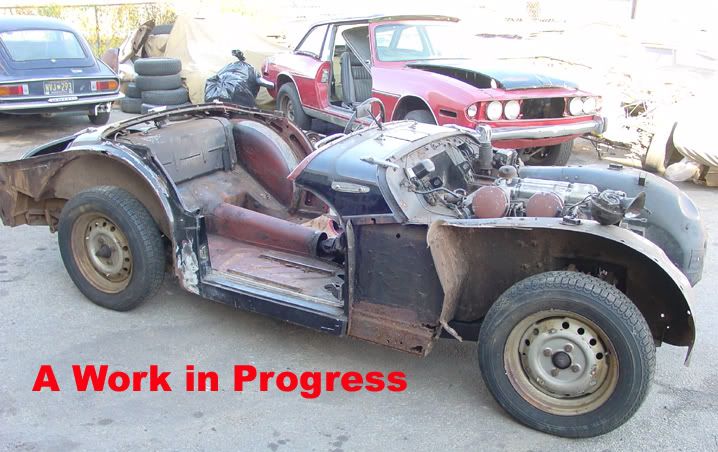
But, we've come a long way since then!
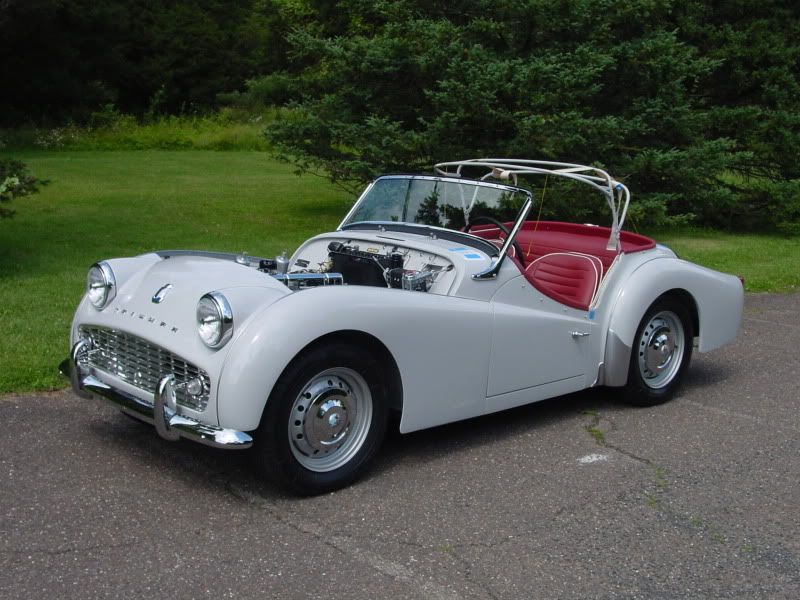
May 2010
-
Thanks for the comments, guys.
-
Should these hood webbing retaining plates be painted or bright plated? If painted, black or same colour as the hood frame?
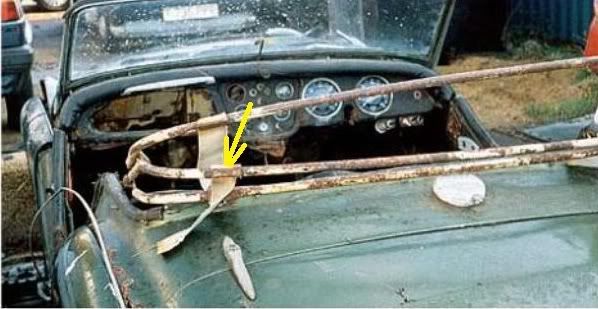
Thanks, and this could be the last nit pickin' question exercise! maybe
Incidentally, we don't have anoraks here, but we DO have hoodies. If you wear a hoodie here you may draw more attention to yourself than you'd like! That said, I don't wear an anorak or a hoodie nor do I engage in anti-social behavior.
-
Hi
The sound is from a real TR. The sound post being produced in Wellington, NZ using one of our TR Register NZ members TR3A. There is an article in our latest mag on the subject with photos showing mics attached to the front wheel, carbs and exhaust.
Brian
Brian: You MUST send this story into the editor for publication in TRAction!
Outstanding.
-
Thanks to all who replied - got this sorted.


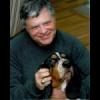
AND another........
in TR2/3/3A/3B Forum
Posted
Outstanding! A real beauty!